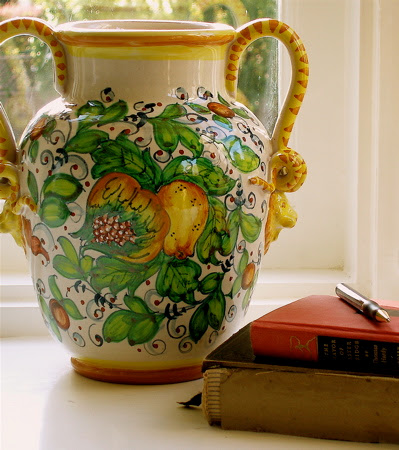 I hadn’t been importing ceramics for long when I got what seemed like a strange request: Do you sell any black roosters?! The answer was no. I had colorful Italian roosters on plates, mugs, bowls, and pitchers, as well as tons of blue and white roosters decorating Mexican pottery, but not one “black rooster” in the collection. While I was a little thrown off by the request for a black rooster, I did have a faint memory of a story related to the black rooster from when a friend and I tasted our way through the beautiful Chianti wine region.
I hadn’t been importing ceramics for long when I got what seemed like a strange request: Do you sell any black roosters?! The answer was no. I had colorful Italian roosters on plates, mugs, bowls, and pitchers, as well as tons of blue and white roosters decorating Mexican pottery, but not one “black rooster” in the collection. While I was a little thrown off by the request for a black rooster, I did have a faint memory of a story related to the black rooster from when a friend and I tasted our way through the beautiful Chianti wine region.
It wasn’t until a few months ago that I realized Ceramiche Bartoloni paints the black rooster. I was ecstatic, both because of the Bartoloni brothers’ unmatched painting skill and because I’d finally have a black rooster for the Emilia Ceramics collection. After all, we’re not talking about any old Vietri pottery rooster, this is a proud black rooster with a story and tons of personality.
And the new black rooster plates from Ceramiche Bartoloni did not disappoint: The dynamic blue, white, and yellow border perfectly frames a proud black rooster getting ready to crow. It’s also the perfect counterpoint to Bartoloni’s colorful rooster ceramic serving platters, bowls, and mugs.
And now to the story about the black rooster, which goes back to the 1200s in Italy. Florence and Siena had debated for years over who had claim to the Chianti region, each wanting it as part of their territory. Finally, the legend goes, leaders decided to settle the matter by a competition. Two knights (or horsemen, depending on your source) would set out at cock’s crow in the morning, one from Florence and one from Siena. Wherever they met on the road would determine the southern border for each city’s claim over the disputed land.
Siena chose a well-fed white rooster as official timekeeper, while Florence picked a starving black rooster. Again, sources differ as to why the black rooster was starving; the Florentines might even have kept it in a box with no food for several days. In any case, when the day of big event came, the black rooster crowed before dawn while the white rooster slept in and only crowed at sunrise. Thus, the Florentine rider traveled much farther than his Sienese counterpart, and the two men met about 19 or 20 km outside of Siena, giving most of the Chianti region to Florence.
 Whether or not this legend is true, the black rooster was branded in 1384 as the emblem for the winemaking League of Chianti and is an important and common symbol for the region. The next time you get a bottle of Chianti, look for the black rooster (gallo nero in Italian) on the seal around the neck of the bottle. Different background colors and borders also represent different kinds of wines, says Wine Trail Traveler.
Whether or not this legend is true, the black rooster was branded in 1384 as the emblem for the winemaking League of Chianti and is an important and common symbol for the region. The next time you get a bottle of Chianti, look for the black rooster (gallo nero in Italian) on the seal around the neck of the bottle. Different background colors and borders also represent different kinds of wines, says Wine Trail Traveler.
 Complete with a legend, I’m excited to offer these new rooster ceramics. Whether you use them as ceramic serving platters or as a unique wall decoration, these black rooster plates are perfect for anyone who loves rooster chic with handmade Italian charm.
Complete with a legend, I’m excited to offer these new rooster ceramics. Whether you use them as ceramic serving platters or as a unique wall decoration, these black rooster plates are perfect for anyone who loves rooster chic with handmade Italian charm.
Rooster wine bottle label image courtesy of Live from Italy.

































 Of course, you don’t have to display wall plates on a wall.
Of course, you don’t have to display wall plates on a wall. 













